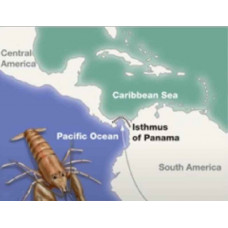A species that has evolved from related forms that are geographically isolated from each other (isolated ranges). Spatial isolation occurs when the range of a widely distributed parent species breaks up. The process of forming new species occurs slowly, over hundreds of thousands of generations. Allopatric populations may be contiguous or isolated.
Species (populations) with vicariance that are geographically exclusive. The degree of interbreeding between such populations depends on the spatial distance between them. Geographic races are therefore allopatric.
From the ancient Greek allos, 'other', and patris, 'home'.
Allopatric geographic speciation is a form of speciation in which the reproductive barrier between species is based on spatial isolation. Such isolation occurs when parts of a population migrate, during geological transformations (e.g. island formation), or due to anthropogenic factors (e.g. agricultural activities).
Divided populations develop genotypic and phenotypic divergence over time as they (a) experience different selective pressures, (b) experience gene drift separately, and (c) experience a different set of mutations.
Thus, subpopulations are not subject to the same selection factors and the selection pressures associated with them are also different. Because of the geographical isolation of the different parts of the range, they evolve more and more independently of each other. When the genetic differences become so great that individuals from two regional groups can no longer produce fertile offspring, the original species splits allopatrically into two or more new species.
In biology, allopatry is the non-overlapping (complete spatial separation) of the ranges of species, subspecies or populations. In the case of allopatric distribution, geographical isolation (separation) prevents encounters and interbreeding in the wild. If the ranges are directly adjacent but do not overlap, this is called parapatric distribution.
The opposite of allopatric is sympatric, where closely related species, subspecies or populations occur in the same geographical area, so that there is a possibility of encounter and interbreeding.
A special case of allopatric speciation is when it occurs due to the isolation of a very small subpopulation, e.g. speciation on an island that is dwindling compared to a much larger parent population. When such a founder population is established, the founder effect leads to genetic drift, which often results in rapid changes in traits.
Under such conditions, the emergence of new species is likely to be much easier. In nature, spatial reproductive isolation occurs in any sufficiently large population because individuals from the extremes are least likely to interbreed with individuals from the centre. If there is sufficient migration and spatial continuity, this effect is compensated for by the continuous redistribution of genes over successive generations. If the range of the population is many times greater than the ability of individuals to disperse, or if there are at least small spatial barriers, then genetic differences will gradually accumulate, isolating local populations and eventually leading to their genetic isolation.
Of all the modes of speciation, allopatric speciation is thought to be predominant.
Allopatric species
Tags: Allopatric species

